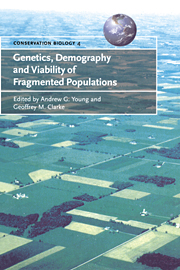Book contents
- Frontmatter
- Contents
- List of contributors
- Foreword by Peter F. Brussard
- Preface
- 1 Introduction: genetics, demography and the conservation of fragmented populations
- Part I Introductory concepts
- Part II Animal case studies
- Part III Plant case studies
- 14 Limited forest fragmentation improves reproduction in the declining New Zealand mistletoe Peraxilla tetrapetala (Loranthaceae)
- 15 Ecology and genetics of Grevillea (Proteaceae): implications for conservation of fragmented populations
- 16 Genetic and demographic influences on population persistence: gene flow and genetic rescue in Silene alba
- 17 Fragmentation in Central American dry forests: genetic impacts on Swietenia humilis (Meliaceae)
- 18 Population viability analysis of the rare Gentiana pneumonanthe: the importance of genetics, demography and reproductive biology
- 19 Genetic erosion, restricted mating and reduced viability in fragmented populations of the endangered grassland herb Rutidosis leptorrhynchoides
- 20 Conclusions and future directions: what do we know about the genetic and demographic effects of habitat fragmentation and where do we go from here?
- References
- Index
20 - Conclusions and future directions: what do we know about the genetic and demographic effects of habitat fragmentation and where do we go from here?
Published online by Cambridge University Press: 29 January 2010
- Frontmatter
- Contents
- List of contributors
- Foreword by Peter F. Brussard
- Preface
- 1 Introduction: genetics, demography and the conservation of fragmented populations
- Part I Introductory concepts
- Part II Animal case studies
- Part III Plant case studies
- 14 Limited forest fragmentation improves reproduction in the declining New Zealand mistletoe Peraxilla tetrapetala (Loranthaceae)
- 15 Ecology and genetics of Grevillea (Proteaceae): implications for conservation of fragmented populations
- 16 Genetic and demographic influences on population persistence: gene flow and genetic rescue in Silene alba
- 17 Fragmentation in Central American dry forests: genetic impacts on Swietenia humilis (Meliaceae)
- 18 Population viability analysis of the rare Gentiana pneumonanthe: the importance of genetics, demography and reproductive biology
- 19 Genetic erosion, restricted mating and reduced viability in fragmented populations of the endangered grassland herb Rutidosis leptorrhynchoides
- 20 Conclusions and future directions: what do we know about the genetic and demographic effects of habitat fragmentation and where do we go from here?
- References
- Index
Summary
There can be little doubt that management of fragmented populations of both animals and plants has become an important element of biological conservation, and will continue to be into the new millennium. Many of the species currently recognised as threatened are restricted to habitat fragments, and the option that was available a century ago, of in-situ conservation within relatively pristine environments, is gone. The continuing global trend towards non-sustainable exploitation of natural resources means that more, rather than fewer, species are going to be affected by habitat loss, degradation and fragmentation in the future. This is particularly concerning as the pressure shifts to tropical ecosystems about which we have much less information on the basic biology of many organisms, and so educated guesses as to biological responses are harder to make.
The facts are now, that if many of the world's endangered species are to be preserved at all, it will be either ex situ in zoos, aquaria or botanical gardens, or in situ in fragmented ecosystems. In the case of ex-situ conservation, we can hope to do little more than preserve a snapshot of evolutionary diversity, as maintenance of genetic and demographic processes becomes almost impossible in the ‘zoo’ context. Avoidance of even common problems, such as loss of stored seed viability through regular sexual regeneration of plant material, is time-consuming and costly and, in any large way, simply impractical. Similarly, the globalisation of breeding programmes among captive-bred populations of animals (an incredibly expensive process), while reducing the immediate problems of inbreeding depression, has limited potential for the long-term maintenance of genetic diversity.
- Type
- Chapter
- Information
- Genetics, Demography and Viability of Fragmented Populations , pp. 361 - 366Publisher: Cambridge University PressPrint publication year: 2000
- 7
- Cited by

